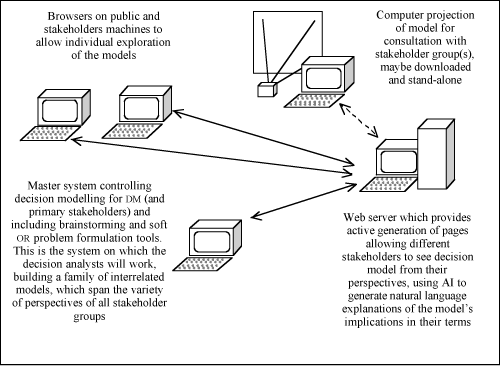|
|||
An e-Negotiation Tool to Support e-Democracyby David Rios Insua, Julio Holgado and Raúl Moreno Scientists at the Statistics and Decision Sciences Group, University Rey Juan Carlos, Madrid, argue that game theoretic solution concepts can be very helpful in developing negotiation systems, which in their turn could be crucial in forthcoming electronic democracy systems. Democracy is the basis of modern society, and the freedom, fairness and equity that it promises have been cherished and fought for over the centuries. With the growth of the Internet and pervasive telecommunications, it now faces a new and positive challenge - that of making the transition to an era of electronic democracy, or e-democracy for short. In essence, this will involve voting by phone or text message, on the web, or through interactive television. There are moves across Europe and elsewhere to explore new ways of voting, initiatives to develop mechanisms of e-government, and in general expectations that our democratic institutions will adapt to the new Information Society. Despite the excitement accompanying the rise of technology, many of the current visions for its use are almost entirely conventional. Political discussion and debate may become more inclusive through the growth of electronic discussion fora, opinion polling may become easier, faster and cheaper via the web, and voting need not involve a cross on a piece of paper but rather a click on a Web site or the sending of a text message. To a large extent, e-democracy is simply envisioned as articulating well-established political and democratic procedures through the mechanisms of modern information and communications technology. Mechanisms exist, however, that could enable a much more substantive implementation of democratic ideals. It is now possible for the public to be more closely involved in societal decision making as pursued, for example, in the European Science Foundation 2003-2006 program, TED (Towards Electronic Democracy - Internet-based complex decision support, see the URL below), which includes several ERCIM groups such as University Rey Juan Carlos, CNR Institute of Applied Mathematics and Information Technology (IMATI) and Trinity College, Dublin. The purpose of TED is to develop an Internet-based architecture for group-decision support, as outlined in the figure below. One potential application is in participatory budgets, allowing residents of a city to decide how the city budget is to be spent. The decision analysis would be undertaken for the problem owner (eg the mayor, the governor or a CEO) by a team of analysts, using a master system which would support the whole process - computer-aided brainstorming, soft modelling techniques and various quantitative techniques such as risk analysis tools, multi-objective utilities and so forth. Throughout the process, several models could be fed onto a server to be accessed by stakeholders and the public at large, allowing them to undertake their own explorations supported by the same tools and to arrive at their own conclusions. The level of access would vary according to the particular stakeholder and the stage of the decision process. Initially, the server could provide pages simply stating that an issue was being addressed, and perhaps inviting comments and submissions via e-mail or through a bulletin board. Later, pages could be developed actively allowing users to interact with part or all of the model and to explore the implications of their individual perspectives and value judgements. These explorations would remain private if the problem owner or stakeholder wished, but more usefully, could provide the decision maker (DM) with a summary.
Once the stakeholders and the problem owner have conducted and communicated their decision analysis, which up to this point has been kept private, an electronic negotiation system could support a negotiation process. Such a search may be guided by one of many game theoretic solution concepts. Among them, we have opted for the balanced increment solution, which will lead our negotiation algorithm (ENS, see the URL below). Our basic tenet is that including and communicating with all stakeholder groups would provide better quality and more transparent decisions. Links: Please contact: |
|||



